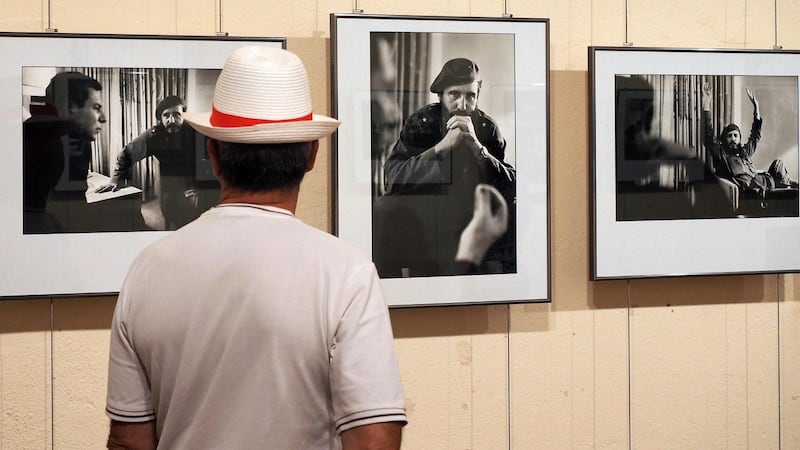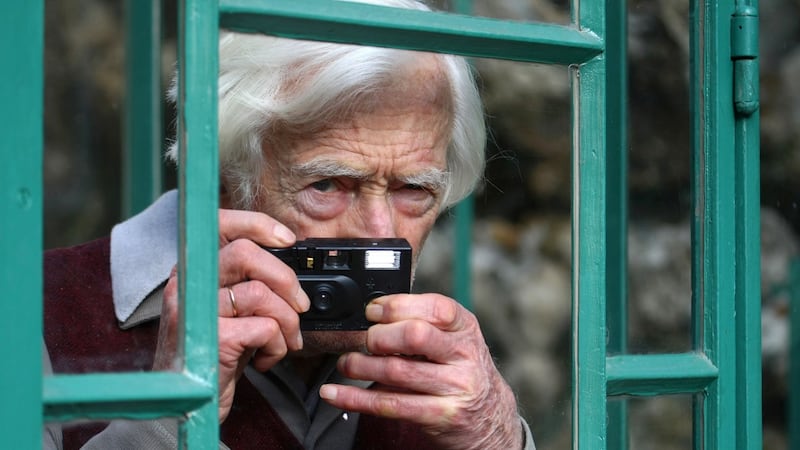On October 21st, 1967, Jan Rose Kasmir (17) went to a demonstration against the Vietnam War outside the Pentagon.
Marc Riboud photographed Kasmir confronting a phalanx of national guardsmen. They brandish bayonets; she holds a chrysanthemum.
The young woman’s expression can be read as pleading or defiant. “I had the feeling the soldiers were more afraid of her than she was of the bayonets,” Riboud said later.


Riboud’s photograph embodied the “make love, not war” ethos of that era. When he photographed Kasmir again, 36 years later, at a demonstration against the Iraq war in London, she carried a poster of the original photo.
Riboud died of Alzheimer's in Paris this week, at the age of 93. The courtesy, kindness and generosity of the last representative of the golden age of photojournalism – when Riboud and his mentors, Henri Cartier-Bresson and Robert Capa, published their black-and-white photos in weekly news magazines – was legendary.
"He travelled the world while taking the time to see it, feel it, reconstitute it through images," photographer Olivier Culmann told Le Figaro. "It was the opposite of our world, which sees itself through selfies."
Ho’s last photographs
Riboud’s photograph of the anti-war protest opened the doors of communist North Vietnam to him. Few other photojournalists were able to cover both North and South Vietnam. Riboud took the last pictures of the communist leader Ho Chi Minh before Ho’s death in 1969.
Though shy and unpretentious, Riboud was, like Cartier-Bresson, a left-wing intellectual who sympathised with the poor and downtrodden. And like Cartier-Bresson, he was from an affluent family.
His father, Camille, a banker with a literary bent, gave him the same Kodak vest pocket camera he used to photograph the trenches of the first World War. “If you don’t know how to talk, perhaps you will know how to look,” Camille Riboud told his taciturn 14-year-old son. Unable to face a second world war, Camille took his own life in 1939.
During the German occupation of France, Riboud and his brothers joined the Vercors maquis of the Resistance. More than four decades later, Riboud would cover the trial of Klaus Barbie, the "butcher of Lyon" who killed his friends in the Resistance.
Riboud’s brothers Jean and Antoine became, respectively, the head of the Banque Schlumberger and the head of the Danone multinational food conglomerate. Marc was expected to get a “serious” job too, but he walked away from a career as a mechanical engineer after spending a summer holiday photographing a festival in Lyons.
Riboud met Cartier-Bresson, who was 15 years his senior, in Paris in 1952. The following year he joined the photographers’ co-operative Magnum, which he presided over in the mid-1970s.
It was the American Robert Capa, another co-founder of Magnum, who helped Riboud place his first photograph in Life magazine. Riboud had climbed to the top floor of the Eiffel Tower, without protection, to photograph “Zazou, the Eiffel Tower painter”. It belongs, like the Pentagon flower girl, to the world’s collective memory.
With a cigarette in his mouth and a hat on his head, Zazou strikes a dancer's pose, reminiscent of Charlie Chaplin or Buster Keaton, while lightly holding on to a latticed girder with one hand.
“I had vertigo every time he leaned over to dip his paintbrush,” Riboud later recalled.
Riboud drove to India, where he lived for a year, then became one of the first westerners to visit revolutionary China, dining with Mao and Zhou Enlai. He said he caught "the Orient virus" and loved nothing more than travelling through Asia.
Globetrotter
Riboud photographed most of the important events of the late 20th century, including Algerian independence, the return of Ayatollah Khomeini to Iran, and the Solidarity movement in Poland.
At the age of 85, he covered Barack Obama’s presidential victory in 2008, and two years later returned to China for the last time.
Yet Marc Riboud did not consider himself a news photographer.
“I am not a globetrotter but a wanderer who loves to photograph the most intense life as intensely as possible,” he told Le Monde in 2010. “I was too shy to join the photographers’ and reporters’ pools. I didn’t know their codes, jargon, tricks and jokes.”
The Castro shoot
In November 1963, Riboud accompanied the French journalist Jean Daniel when the latter travelled to Cuba to interview Fidel Castro in a Havana hotel room.
His photographs of the Lider Máximo are on exhibition this week at Visa pour l’image, the annual meeting of world photographer in Perpignan. Tomorrow night’s closing session of Visa pour l’image will be dedicated to Riboud.
After a very long interview, the Cuban leader took the two Frenchmen on a tour of the island. It was, as Riboud's widow, Catherine Chaine, wrote in the introduction to the Perpignan show, "the kind of scoop that doesn't happen anymore".












